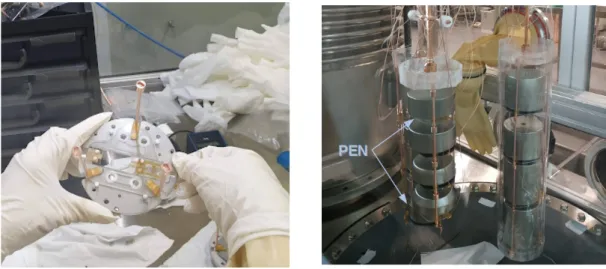background experiments
I. Abt, 𝑎 Y. Efremenko, 𝑐 M. Febbraro, 𝑏 F. Fischer, 𝑎 M. Guitart, 𝑎 K. Gusev, ℎ B. Hackett, 𝑐 C. Hayward, 𝑑 R. Hodák, 𝑒 P. Krause, ℎ B. Majorovits, 𝑎 L. Manzanillas, 𝑎,∗
D. Muenstermann, 𝑑 R. Pjatkan, 𝑖 M. Pohl, 𝑓 R. Rouhana, 𝑓 D. Radford, 𝑏 E. Rukhadze, 𝑒 N. Rumyantseva, ℎ I. Schilling, 𝑓 S. Schoenert, ℎ O. Schulz, 𝑎 M. Schwarz, ℎ
M. Stommel 𝑔 and J. Weingarten 𝑓
𝑎
Max-Planck-Institut für Physik, 80805 Munich, Germany
𝑏
Oak Ridge National Laboratory, Oak Ridge, Tennessee 37830
𝑐
Department of Physics and Astronomy, University of Tennessee, Knoxville, Tennessee 37916
𝑑
Department of Physics, Lancaster University, Lancaster
𝑒
Czech Technical University, Institute of Experimental and Applied Physics, CZ-12800 Prague
𝑓
Technische Universität Dortmund, Dortmund
𝑔
Leibniz-Institut für Polymerforschung Dresden e.V., 01069 Dresden, Germany
ℎ
Physik Department, Technische Universität, München
𝑖
Nuvia a.s., 67401 Třebíč, Czech Republic E-mail: manzanil@mpp.mpg.de
PEN is an industrial polyester plastic which has become interesting for the physics community as a new type of plastic scintillator. PEN scintillates in the blue regime, which is ideal for most photosensor devices. In addition, PEN has excellent mechanical properties and very good radiopurity has been achieved. Thus, it is an ideal candidate for active structural components in low-background experiments. One possible application are holders for germanium detectors operating in cryogenic liquids (LAr, LN2). Such structures can help to reject surface and external backgrounds, boosting the sensitivity of experiments. In this contribution, the R&D on PEN is outlined and an evaluation of the first production of PEN structures for the LEGEND-200 experiment is reported.
40th International Conference on High Energy physics - ICHEP2020 July 28 - August 6, 2020
Prague, Czech Republic (virtual meeting)
∗
![Figure 1: Left: Example of inactive copper structures used as support for the Ge detectors in the Majorana experiment [2]](https://thumb-eu.123doks.com/thumbv2/1library_info/3996044.1540102/2.892.140.758.584.737/figure-example-inactive-structures-support-detectors-majorana-experiment.webp)

